GUN DOGS
Do you hunt with your pointing breed dog?
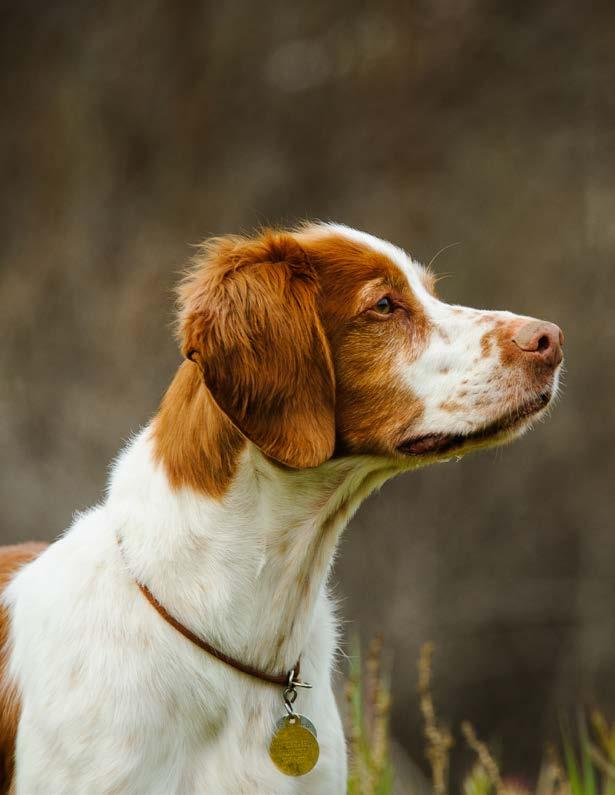
SHED HAPPENS!
Why dogs shed and what you can do about it.
DOG TRAINING IN A COOKIE CUTTER WORLD
There is no template to follow, the same problem is not always the same solution.
TAKE THE LEAD
The importance of clear communication in dog training.
SPRING 2024 VOLUME 2 ISSUE 2
PAW Quarterly
FREE pawquarterly.com
LIFESTYLE SPORTS GROOMING AND MORE
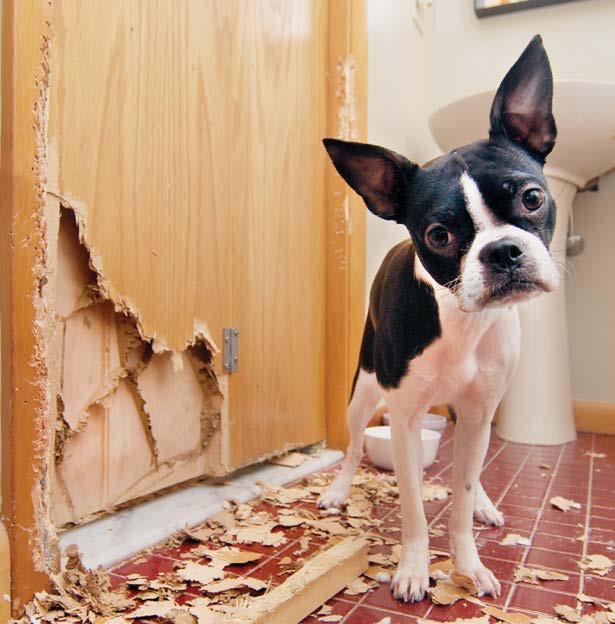
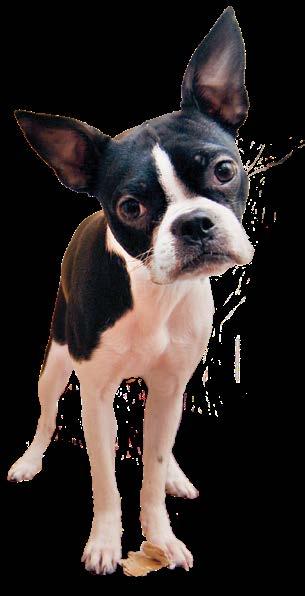

ESTEVAN • WEYBURN • REGINA 306.721.7140 4830 Gordon Road, Regina, SK | erin_associates_insurance@cooperators.ca It attacked me first! You have insurance for this right? Ask us about your pet damage insurance options.
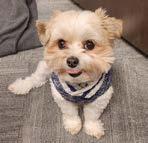
NOTHING BETTER THAN SWEETER WEATHER.
Editor
Rob Caleval
The snow is melting, the days are getting longer, and the temperature is (oh so slowly) beginning to rise. It looks like spring is finally on the horizon! Which means the second year of Paw Quarterly is well under way. And so we present our annual spring edition for your reading pleasure, packed cover to cover with information and entertainment about dogs of all kinds, and the people who love them.
What do we have for you this time? I'm glad you asked, because it's a doozy! Articles on bite prevention and grooming for seasonal shedding are just the beginning. We've also got some great pieces on training, including how to clearly communicate with your dog, and training in a Cookie Cutter World – not every approach is the same even if the problems are almost identical. You want more? How about some pointers on getting your pet's weight under control? Or here's an article on hunting with Pointer Breed dogs. More still, you say? You got it. Here's a personal favourite - how to tell your pet's story through photography. Honestly, even I'm surprised by how much we can pack into a single issue!
So my friends, both canine and human, let's say goodbye to those winter blues and embrace the coming warmth. We've earned it.
PAWQuarterly SPRING 2024
Volume 2 | Issue 2
CONTRIBUTING EDITOR
Rob Caleval
Editorial Enquiries publish@pawquarterly.com
DESIGN & PUBLISHING
Tracy Hahn
CONTRIBUTORS
Emily Garland, Nicole Vaughn, Derrick Fox, May Fischer, Carly Patryluk, Lisa Brice, Alex Zdanowski, Patti Lee & Randi Benko.
ADVERTISING & SALES
sales@pawquarterly.com
SOCIAL
PAWQuarterly.com
All
PAW Quarterly
PAWQuarterly is independently owned and published in Regina, Saskatchewan. Opinions and advice expressed in PAWQuarterly are those of the authors and do not necessarily reflect the views of the publisher or advertisers. PAWQuarterly does not assume liability for content. Articles and information are published for information purposes only. For training, health, or nutritional advice specific to your pet, consult with a trained professional.
Rob
rights reserved ©PAWQuarterly. Reproduction in whole or in part without permission is prohibited. For reproduction requests, please contact publish@pawquarterly.com.
3 PAWQuarterly
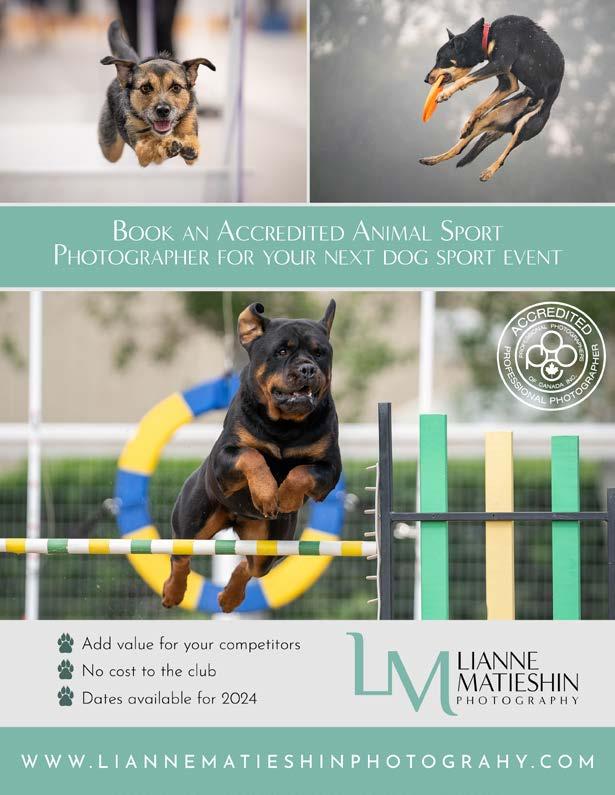
14
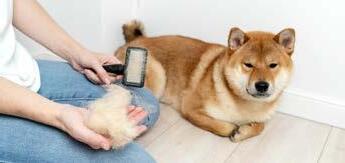
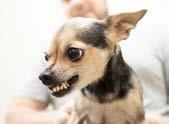
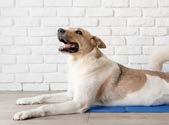
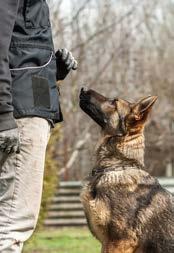

8 Spring Fever
10 Bite Prevention
13 Telling your Pet's Story (Photography)
14 Shed Happens!
16 Dog Training in a Cookie Cutter World
18 Take the Lead: Clear communication
20 Gun Dogs (Sport)
23 Is My Pet Over Weight
28 Events Calendar
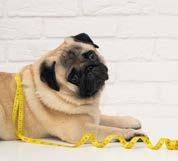
SPRING 2024 IN THIS ISSUE
18 10 16 20 23 5 PAWQuarterly


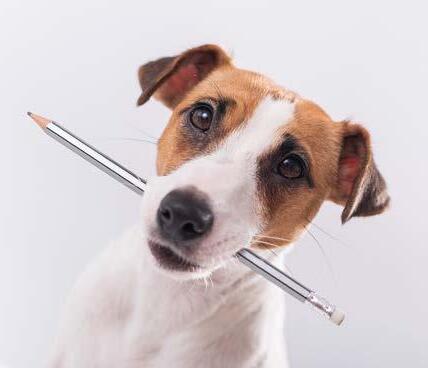
Rob Klinger Financial Advisor 1014 Winnipeg Street, Regina, SK p. 306.565.6774 e. rob.klinger@edwardjones.com edwardjones.ca/rob-klinger PROUD TO SUPPORT LOCAL BUSINESS MAKING SENSE OF INVESTING Publish with us We are always on the look out for great content. Interested in contributing? Email us at: publish@pawquarterly.com 6 SPRING 2024 | PQ 2.2
2.2
CONTRIBUTORS
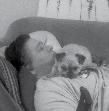

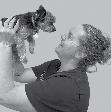
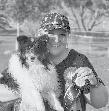
ROB CALEVAL
Rob’s poetry and short stories have been published in print and on line. He has a BA in English Literature, and has worked for 17+ years as an Emergency Medical Dispatcher. He spends a significant portion of his free time impersonating a dog bed.
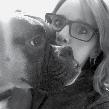
EMILY GARLAND
Emily is a Dog Trainer and Behaviour Specialist with over 10 years of experience in SK and BC. She enjoys hanging with her pack and participates in flyball, agility, rally-o, and stunt. Emily and her rescued Border Collie Jinks became the first titled Canadian Stunt Dog Team.
CARLY PATRYLUK
Carly is the owner of House of Paws Pet Boutique and is certified in a variety of pet nutrition areas. Carly believes in continuous learning and when she’s not working with pet parents at her store, she spends her time developing new and engaging methods to empower pet parents to make the best choices for their pet’s nutrition.
MAY FISCHER
May is an owner/instructor at 4 Limb Gym, competitively training for over 14 years. She Co-Captains her own flyball team and has many titles and awards in barn hunt, rally-O, flyball, and obedience. She is a certified trick dog instructor, stunt dog judge, fitness coach, and is a therapy dog, CGN, and animal actors evaluator.


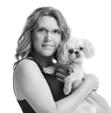
TRACY HAHN
Tracy is a multimedia designer and desktop publisher by day, and a dog sport and training enthusiast by night. Her Olde English Bulldogge, Jack Russell Sport Mix and Mini Heeler Mix keep her busy doing flyball, nosework, agility, and tricks.
NICOLE VAUGHN
Nicole is a veteran dog groomer, trainer, and partner of the Good2Go Dog Sports Club. When she’s not busy making dogs beautiful, you can find her playing flyball, disc, tricks, and agility with one or more of her pack.
DERRICK FOX
Derrick is currently serving as a member of the Regina Police Service where he has served for almost two decades. Ten of those years were spent in the Canine Unit wherein he was a handler and provincial trainer. Derrick is a member of the CAPDT and IACP and focuses his canine training practice with both working and companion dogs.
LISA BRICE
Lisa operates Brice Photography out of her home studio with her faithful sidekick Chloe. She knows how important pets are to a family and enjoys being a part of the process in creating something special to display in her clients' homes. Lisa says the best thing about being a photographer is the fun and laughter during a session.
7 PAWQuarterly
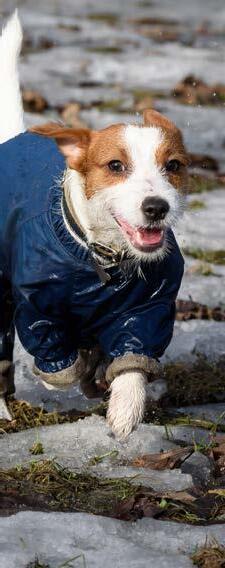
THINGS TO DO
Outdoor Training
Play Fetch
Take a Hike
Hunting or Field Sports
Backyard Agility
Obstacle Course
K9 Parkour
Sniffing
SPRING FEVER GRAB YOUR LEASH AND LET'S GO FOR A WALK
The sun is shining, the birds are chirping and it's time to get re-introduced to the great outdoors. Spring is finally here and everybody is itching to get out of the house. We may even find that we need to brush up on our leash walking skills and start conditioning our pets for the summer months.
Get Some Exercise
Being couped up all winter may have resulted in a little weight gain for us and our dogs. It's time to start walking again and building up our stamina for the warmer months ahead. While some people and pets stay active all winter long, a lot of us live out the winter in slower and quieter environments.
In the spring dogs can experience sensory overload and we may think that they are over excited, not listening or generally behaving badly. In reality, there are so many re-emerging sights, sounds and things for our pets to explore and Spring Fever is out in full force.
Getting outside will not only help them physically, but it will stimulate them mentally and socially too. Both ends of the leash can brush up on loose leash walking, recall, and get a chance to explore new areas. It will work out some of that pent up energy.
Never stop training.
Whether you had good leash skills or not, spring is a great time for a new start. Working on behavioural issues or obedience training while you are out for a walk will not only help with a better behaved dog, but will tire them out mentally and physically.
Who says sand boxes are just for kids!
When you're picking weeds in your yard does your dog try to help by digging along with you? Why not designate an area in your yard for your dog to do their own digging. If you are into scent or search work, you can bury items for them to search out while letting them enjoy their natural digging instincts.
What's a little dirt or sand to wash off when you are creating an enjoyable enrichment activity for your dogs.
No matter what activities you decide to do be sure to bring some high-value treats when you are out and about to reward good behaviour and a little extra incentive for when Spring Fever hits harder than you expect.
8 SPRING 2024 | PQ 2.2
New Walking Route
& Scent work
Spa Day Tour Pet Friendly Business
TURNING UP THE HEAT SPRING OPENER FLYBALL TOURNAMENT
The first flyball tournament of the 2024 calendar year in Saskatchewan was hosted by KAOS Dog Sports.
There was a lot of excitement to be back in the lanes and a new spark for the game after the long winter break. It was fun to see what clubs have been working and improving on over the off season.
A lot of the greener dogs last year were proving themselves to be reliable and dependable. Clubs were trying out different line ups with different dogs in new positions. We were also happy to welcome some new dogs and people, which is always exciting to grow the sport.
During the off season, you don't get to see many people from other clubs so it is nice to catch up with everyone. All the clubs were chatting, joking around, and having a great time together. It's also always fun to see everyone's baby puppies come out during the breaks.
On the contrary, there is no way to replicate a tournament environment at practice or over the off season. Some dogs came up with new problems that judging by the comments from their club, have never surfaced before. This happens at times and gives them a training focus for the weeks leading up to the next tournament at the end of April. It was exciting to hear clubs discussing what they want to work on, what goals they have for the season, and see some of that start to take shape as the weekend went on.
Good luck and happy racing to all in 2024!
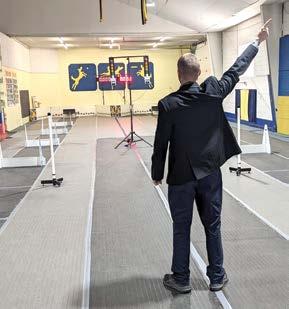
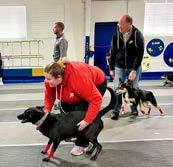
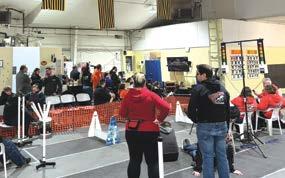
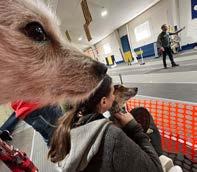 ALEX ZDANOWSKI
Judge, North American Flyball Association
ALEX ZDANOWSKI
Judge, North American Flyball Association
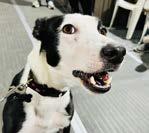
9 PAWQuarterly
BITE PREVENTION
By May Fischer
Bringing up the topic of dog bites can take an easy Sunday afternoon chat and launch it into a no-holds barred cage match amongst the most respected acquaintances. Conversations can take sharp turns in many directions to try and determine the true cause. Debating things like breed, nature vs nurture can easily escalate into less than civil discussions due to people’s passionate love of their four-legged companions, combined with their own personal experiences.
Our goal is not to get into such granular deliberations, but rather, to review ways which you can avoid being in a situation to be bitten in the first place. Prevention starts with preparation.
Living in Canada has its advantages but getting current information on our country’s dog bites stats isn’t one of them. There are several reasons for this, but again, the focus isn’t for us to nail down cause, but rather for us to use this information to prevent them in the first place. Particularly with our most at risk: children.

Dog Bite Statistics 1
1 https://www.dogster.com/lifestyle/dogbite-statistic-canada, article written by Kathryn Copeland, updated March 2024 by Kathryn Copeland
1
Why do dogs bite?
It of course depends on the dog and situation, but often it’s because they feel threatened personally or for something they value, like a toy or food. Dogs who are ill or in pain can also be asking to be left alone. And the truth is, any dog can be pushed to bite under the right circumstances.
Despite us moving our dogs from outdoor working staff to indoor Lords of Leisure, we don’t always know as much as we should about them. We often say how nice it would be to know what our dogs are thinking, however, when they do try to tell us, often we aren’t listening.
2
Most commonly bitten are Children Ages 5-9
it’s estimated that there
over
Dog Bites Annually
In Canada,
are
500,000
10 SPRING 2024 | PQ 2.2
PREVENTION WEEK APRIL 7-13
Many people feel bites come out of nowhere, but more often than not, there are warning signs leading up to the event. Yawns, lifted paws, whale eyes, backing away, tucked tails, flattened ears are all signals dogs give us indicating their discomfort.
Understanding a dog’s body language is one of the most important things we can learn as guardians. Not only to help our dogs communicate more clearly, but also to inhibit their need to tell us “louder”.
As an owner, its our job to socialize our dogs in various scenarios so that the world is less scary to them. Dogs go through a few fear periods during their transition from puppy to adulthood, and working through the things that make them afraid, will help to lessen their stress levels. Bite inhibition and impulse control are a few other foundations that shouldn’t be overlooked during their formative months. And while we might not be able to make them comfortable with everything, we can try to prepare them for familiar situations they will encounter during their lifetime.
As a parent, its our job to ensure our children understand a dog’s need for space. Little hands that grab fur or tails,
3 Most commonly bitten areas Hands, Face & Neck Adults Children
voices that squeal, and toys or beds that are invaded, can be triggers to a dog that they are at risk and need to act because no one else is. It is up to us to teach our children to respect animals by not allowing them to climb on or tease them, and most importantly, never leave them alone together. Even momentarily with the most serene of dogs. We have to remember that at the core, dogs are animals and children are undeveloped humans and should be treated as such.
As adults, we need to stop thinking that every dog wants to meet us or our dog. You should never approach another dog’s space unless you ask the other owner whether or not its ok. And whatever the answer is should be respected and not taken personally. If someone says no, its not because of you. They’re likely just working through something with their dog and need the space.
Owners should feel comfortable advocating for their dog’s space. If your dog is giving signs they are uncomfortable, remove them from the situation. Get comfortable telling people “no, thank you” when asked if they can pet your dog or have their dog meet yours. Its your job
to ensure good interactions which will help boost your dog’s confidence. If a straight no seems too harsh or out of your own comfort level, you can just say they aren’t feeling themselves today so maybe another time.
When we don’t advocate and people hover over our dog, raise their hands above their heads, encroach upon their space when eating or chewing, we are allowing behaviours that can be considered threatening to an animal’s security. Give your dog permission to choose the interactions they have versus it being forced upon them.
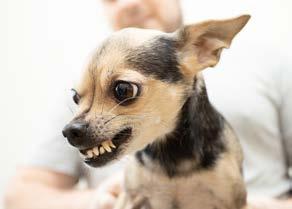
4
One to two fatalities estimated per year from dog attacks in Canada.
Fatalities
Between 1990 and 2007, 24 of the 28 fatalities were children under 12.
5
The prairie provinces had the Highest Incidents of fatal dog attacks.
11 PAWQuarterly
BE A TREE
Doggone Safe programs like Be a Tree through The Pet Professional Guild can offer additional educational services for schools and groups.
BODY
Stand still with legs together and arms at your side or clasp your hands together low in front of you.
PROTECT
If you are knocked down, use your arms to cover your neck and head and curl into a ball.

BITE PREVENTION
WEEK APRIL 7-13
The program provides information in a way that can easily be understood by adults and children alike. One of the main takeaways, is to teach your child to act like a tree when encountering a loose or excited dog.
HEAD & EYES
Don't make eye contact. Look down at your feet, not directly at the dog.

QUIET & STILL
Avoid hitting, running, screaming, or yelling as it will only increase the dog’s arousal.
This is a big topic and there are many things to comprehend. Too many for one article. So this year, celebrate National Dog Bite Prevention Week by reading up on additional safety and training tips, along with reading body language cues. And don’t forget to share this information with your family and friends - it could save a life.
MAY FISCHER Owner, Instructor and Certified Evaluator at 4 Lymb Gym.
12 SPRING 2024 | PQ 2.2
TELLING YOUR PET'S STORY
Every pet has a story and a skilled photographer can capture the true spirit of an animal through their lens.
This can be accomplished with knowledge and understanding of the animal. Watching for cues such as a happy wagging tail, stressed with panting, timid, or scared with the ears back will determine how the story will be told. Dogs are great at finding joy in the simplest of things, catching a ball, a treat, and just laying down in the moment.
The environment can play a key role in the success of the story you want to tell. A one-on-one situation with very little to no distractions will help the animal be more relaxed and more likely to cooperate. The controlled environment, in a studio for example, can be a funfilled session by introducing all their favorite things. Treats, toys and even a little peanut butter can go a long way to achieve what you want. If the desire is for a calmer, quieter, more cooperative dog, then its best to leave the treats and toys out of the session.
The type of breed can work well in conjunction with the environment to tell your pet's story. If the breed of your dog loves water such as the Labrador Retriever, allowing the dog to run and play in the water or pose by a lake can create some amazing images. Dogs in urban environments like the French Bulldog or Dachshund who are accustomed to city life can be captured strolling through parks and showing off their social skills. Seeking out your favorite location such as an iconic bridge, a popular street, or the city landscape in the background can help tell a story that fits well with your dog.
Time and patience are essential when it comes to animals.
Giving the animal time, and waiting for the right moment to capture different behaviours will create different opportunities. Watching for the ears to perk up, waiting for them to swallow so you capture them with their mouth closed, and waiting for them to relax will help capture their personalities. A photographer will have creative ways to get the animals attention using distractions or noise makers for that perfect shot.
The environment, type of breed and the patience of the artist, all contribute to the visual creation that celebrates the uniqueness of your pet. Every animal has a story to tell, and every pet owner loves to share their story. Create a story that will live on in your home and heart forever.
LISA BRICE Article & Photo by Brice Photography
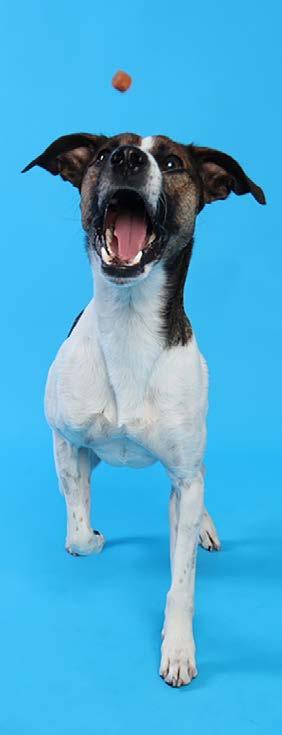
13 PAWQuarterly
SHED HAPPENS!
As we leave winter behind and temperatures start to rise, you are likely to find more and more loose dog hair billowing about your home.
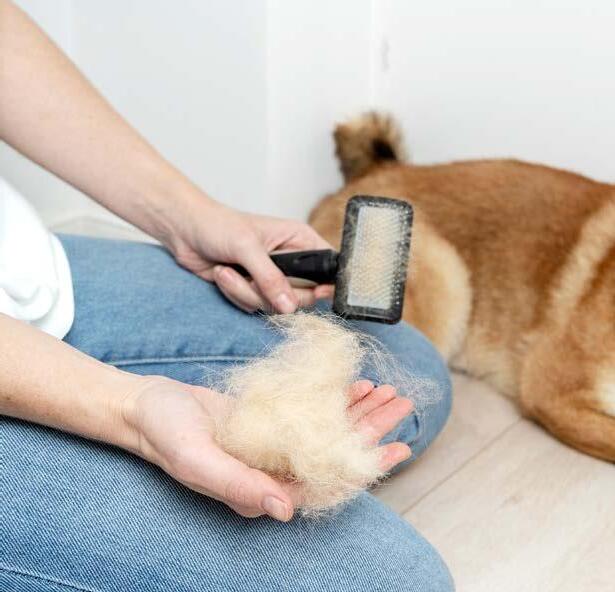
14 SPRING 2024 | PQ 2.2
Seasonal changes, as well as a dog's environment, breed/mix, age, health, nutrition, and stress levels all factor into how much they will shed throughout the year. Some breeds are known to "blow coat" and do a big shed a couple of times per year, while most will shed year-round, especially if they spend a fair amount of time indoors.
WHAT'S NORMAL?
What is considered a "normal" amount of shedding can really vary between dogs.
Many people falsely believe a shorter coat means a dog will shed less, or that "non-shedding" breeds will not
shed at all, but that is simply not the case. What's more, dogs that are not fully mature may not shed as much as they will once their puppy coat is fully replaced.
Every dog's coat grows in cycles, in what is called a mosaic pattern, which helps a dog's body avoid bald patches while allowing them to grow or shed hairs to adjust to environmental and other changes. Dogs that have shorter and/or denser coats go through this process of dormancy, hair loss, and regrowth much more quickly, producing a lot of shed hairs, while dogs that have longer coats shed individual hairs much more slowly like humans do.
COAT CARE
Frequent bathing and brushing can help keep shedding hair on your dog, and thus around your home to a minimum. There are numerous products available, from specialty shampoos and conditioners, to various deshedding tools that a professional groomer can help you select for your dog's coat type that will make at home care, between grooming appointments, more enjoyable and efficient.
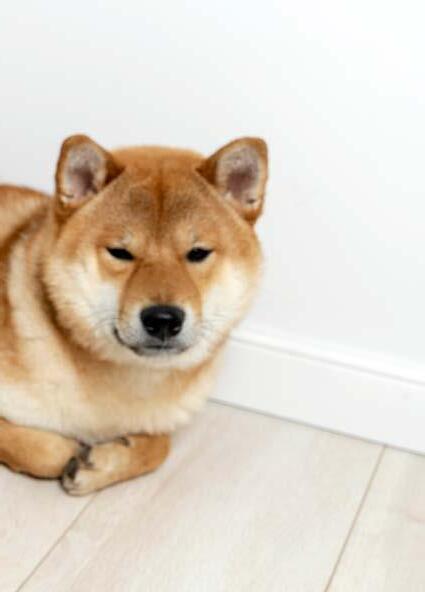
You might also want to ask your dog's veterinarian about appropriate supplements, such as various oils, that can support the natural process of shedding, and help keep your dog's skin and coat looking great!
PLEASE NOTE...
Shedding that is accompanied by itchiness, dander, brittle hair, scabs, and/or patchy areas is not normal and should mean a trip to your dog's veterinarian ASAP.
Nicole Vaughn, Grooming Manager at Pawsitively Perfect
With over twenty years of professional grooming experience, Nicole is always happy to help people keep their dogs clean and happy.
15 PAWQuarterly
DOG TRAINING in a COOKIE CUTTER WORLD
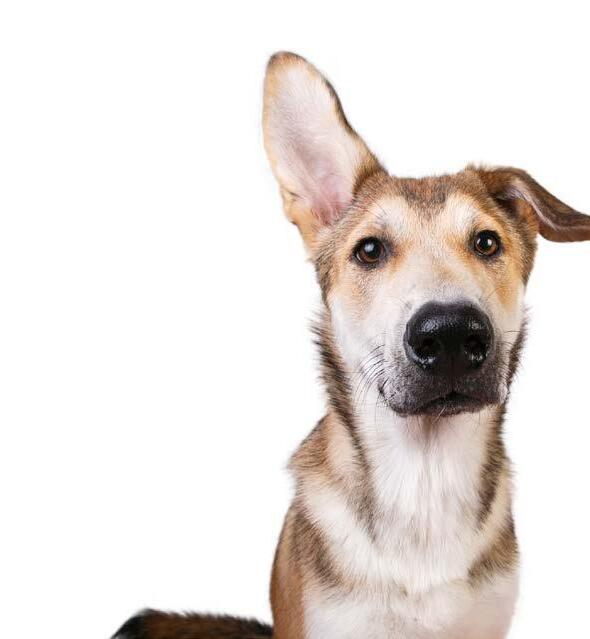
Every semester I teach at least 20 handler and dog teams the beginning steps of how to modify leash reactive behavior. At the surface it seems simple: the dog barks, lunges, growls, pulls and carries on like a nincompoop.
Underneath is the more difficult part. The problem is Reactivity is a symptom of other problems and many problems can create reactivity. Though our core skills for behavior modification are the same, how they are implemented for best effect is another matter entirely, which is why it is insanely difficult to give more than surface level advice without working in-person.
Training, especially behavior modification, requires good technique, but it also requires a lot of feel and timing. In this way dog training is part art and part science.
This past semester two of my students had young rescue husky mixes. Approximately the same size, same age, and with many similarities. Both were frustrated by their leashes, both generally excited but not aggressive. On paper, this was the same problem.
Except they needed two entirely different things. Why? Because although the dogs were similar, their handlers weren't!
We are never teaching the dog alone. We are teaching them in relation to their handler(s). Together they are a team.
16 SPRING 2024 | PQ 2.2
HERE’S THE SCENARIO
DOG #1
Let's call him Axel.
Axel couldn't care less about his owners. They were doormats to him. Even with solid technique, he needed to learn to care about the other side of the leash, especially with one partner.
Axel’s front-running problem was zero connection. He needed his handler to step up to create and enforce boundaries while being generous with his reward structure. When the handler was able to do that, connection started to happen. When connection happened the Reactivity (at least in the classroom) all but vanished.
DOG #2
Let's call her Belle.
Belle actively cared quite a lot about her handler. Her handler was also very sharp, dutiful and militaristic. He wasn't punishing or mean by any stretch, but he had a (somewhat rare) ability to make his dog snort fire simply with the regimented military like presence he brought to the work.
He had a natural level of intensity most high end handlers want to bring to their obedience or protection work. However, on that leash his intensity gave her intensity, which created a tornado of reactivity. The handler had created a dragon. Once we softened the human end of the leash, the dog too was able to soften, think and
respond, and much to my pleasant surprise was not nearly the dragon I thought she might be.
Same problem.
Same type of dog.
Same age.
Same skills.
Different handlers. Different focus in the execution.
If Axel's handler got advice to be softer and sweeter, they'd still be stuck and the dog would have never started to clue in to anything at the other end of the leash. If Belle's handler got advice to put anymore energy into their dog, she'd only learn how to breathe fire hotter and faster.
As much as a trainer, behavior analyst or behaviorist rely on the dog’s side of information, we also have to look and address behavior modification on the human end. From how someone holds a leash, to their pace, to where they look, to their muscle twitches, to the way they hold their back - it’s all behavior. With a savvy coach and a lot of effort, together, the human’s behavior and the dog’s behavior can be pulled towards the desired goals.
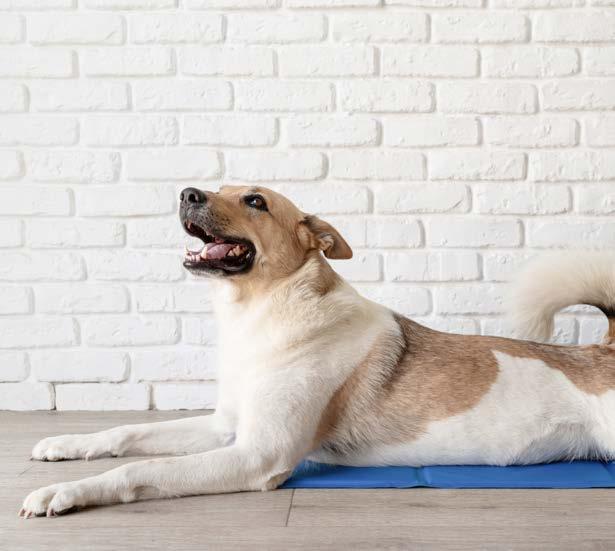
If you’re ever looking for behavior help with your dog, make sure that they treat you and your dogs as individuals versus giving you a prescription to follow. Behaviourally speaking, make sure they coach you and not just the better looking side of the leash.
HappyTraining!
EMILY GARLAND, CPDT‑KA, MFA Trainer and Behavioural Specialist
17 PAWQuarterly
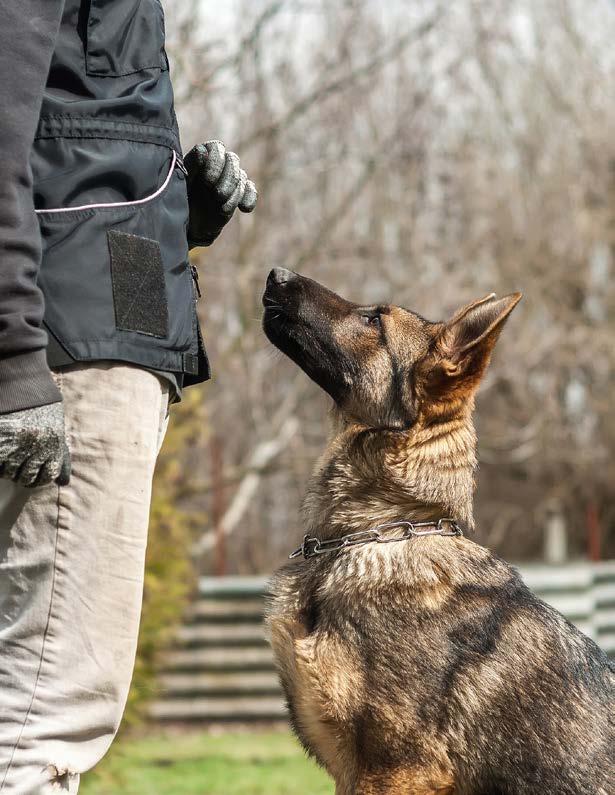
Take the LEAD
The importance of clear communication in dog training.
Why Clear Communication Matters
When training your dog, think of yourself as a parent. Just like in raising children, an invested parent helps children understand what's needed by giving clear instructions. For your dog, you are that advocator. Clear communication means telling your dog exactly what you want in a way they can understand. It's about being consistent, just like using a red light to mean 'stop' every time.
When communication is clear. We thrive in learning and our relationships flourish as there is no anchoring frustrations or inconsistencies.
How It Helps the Handler
For you, the dog's handler, clear communication can make training easier and more enjoyable. I had an opportunity once to work with a man who coined the phrasing “Dancing with Dogs”. It’s true When both you and your dog know the steps, you dance together smoothly. If you're clear and consistent, your dog is less likely to get confused. This means less frustration for both of you and more fun times.
There is nothing quite like running a leash out the end of your hand and knowing that your partnership through communication brings about success. Whether applied through verbal markers, leash pressure or otherwise, it is a pretty surreal feeling to communicate with an animal in this way.
How it Helps the Dog
In relationships, we value consistency and dependability. So too does your dog. Great communicators capture attention, beseech value and moreover, maintain an audience. Dogs thrive in the consistency of what is. They are only motivated by bettering their situation. If you give the map to find value, they will carve out the path to it.
The Power of Using Markers
Markers are like the gold stars you get in school for a job well done. They tell your dog, "Yes, that's exactly what I wanted!" You can use a word like "Yes!" or a clicker, which is a small device that makes a clicking sound. The important thing is to use it the same way every time. Give your dog a treat after you mark the good behavior, and they'll soon understand that the mark means they did something great. Markers also allow for human error and inconsistencies. They bridge a gap in time so that our reinforcer maintains its effectiveness. It’s a promissory note.
You wouldn’t mind waiting a few seconds for someone to write you a big fat cheque, would you? A marker is that promise.
Keeping It Simple and Fun
Remember, whether you're a kid or an adult, learning is easier when it's fun. Keep your training sessions short, sweet, and full of positivity. If you’re going to dance with your dog. Why not take the lead. First, Understand, then motivate and communicate.
Being clear helps the dog find its way to good behavior. For the handler, it's a simple means of providing feedback. By using markers and keeping things upbeat, you and your dog can look forward to training time.
It's not just about obedience or behaviour modification; it's about building a friendship based on understanding and mutual respect.
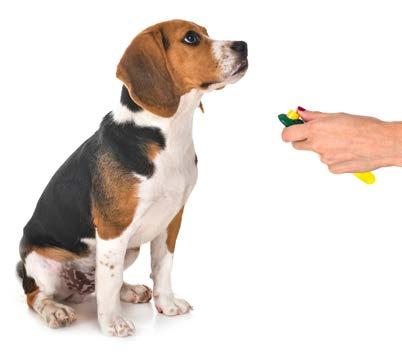
Derrick Fox, IACP, CAPDT
Owner / Operator
Fido and Fox K9 Training Services
Professional Canine Trainer
19 PAWQuarterly
GUN DOGS
Do you hunt with your Pointing breed dog?
One of the first things people ask me when they learn that I have a “gun dog” is “Do you hunt with him?”
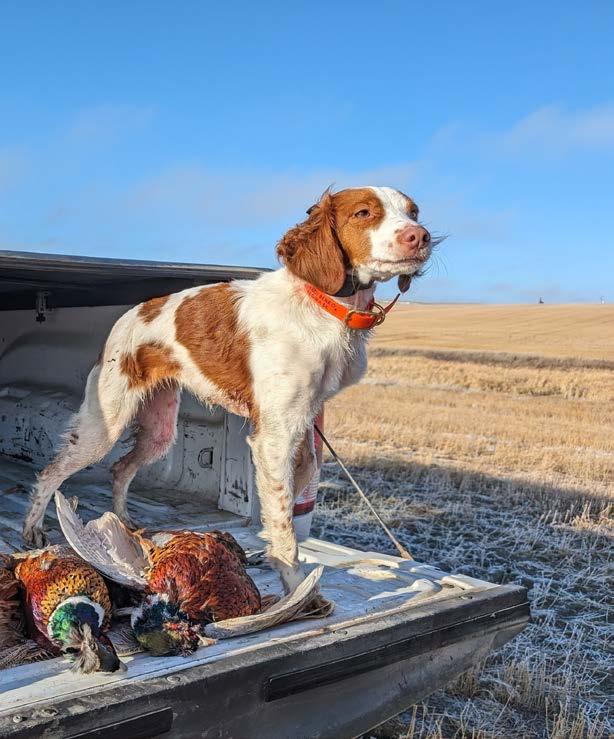
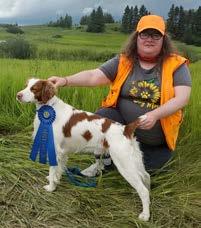
Picture it . . .
Regina, 2017. I’m looking for a somewhat sportier dog than the little cocker spaniel mix we had adopted from the shelter. In swoops my friend Emily, suggesting a Brittany since there was a reputable breeder in Saskatoon. Thus, my journey to learning about my upland bird dog begins!
Patti and Bonhomme - qualifying run during a Field Dog Test, Torrington, Alberta.
20 SPRING 2024 | PQ 2.2
Teal – First solo hunt limits out with 3 roosters.
Hunting with a companion dog has been done for centuries, and it is still one of the most popular sports in many parts of the world. I figured out pretty early on that my upland bird pointing dog, Bonhomme, was not fully happy unless his nose was working. He made it abundantly clear. In early spring 2019, I signed us up for an online course that taught the fundamentals of hunting with a gun dog. I would come to find that, much like many other resources, this course was geared more towards The Retrievers and less so towards The Pointers. Nonetheless, we were ready for our first hunting season in Fall of 2019, when Bonhomme turned two. I was not prepared for what happened next.
I completely fell in love with the field, and with hunting over my own dog. We did as much hunting as we could that fall, and over the next year, we earned some ribbons and a title in a field dog test. Great!
In 2021, I concerted my efforts to host events locally in Saskatchewan.
I hosted a CKC Field Dog Test near Fort Qu’Appelle, under the collaborative auspices of the Brittany Spaniel Club of Canada (BSCC). As event superintendent, the opportunity to learn was bountiful!
Since then, I have traveled several times to Alberta for more competition, and to the Northern US to compete. Below is a basic outline of some popular organizations’ test/trial events.
The CKC Field Dog Test for Pointing Breeds
“The purpose of field dog tests for pointing breeds is to encourage the development and use of those natural abilities for which pointing dogs were originally bred. Pointing dogs were selectively bred from dogs who exhibited pointing and retrieving from land and water instincts. These tests assist breeders who strive to enhance breed improvement by selecting breeding stock that have strongly demonstrated these fundamental breed traits.” ~ Canadian Kennel Club
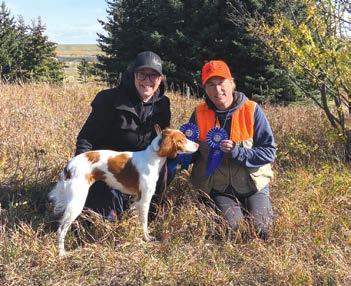
THERE ARE 4 LEVELS OF TITLES IN THIS TYPE OF EVENT:
LEVEL 1 • Field Dog Junior
Elements required: Desire to hunt, style running, pace, range, pattern, control, pointing, and reaction to shot.
LEVEL 2 • Field Dog
Elements required: Desire to hunt, style running, pace, range, pattern, control, pointing, reaction to shot, and retrieve on land.
LEVEL 3 • Field Dog Advanced
Elements required: Desire to hunt, style running, pace, range, pattern, control, pointing, retrieve on land, and backing.
LEVEL 4 • Field Dog Excellent
Elements required: Desire to hunt, style running, pace, range, pattern, control, pointing, steady to wing and shot, retrieve on land, backing, retrieve from water.
A dog must achieve all of the elements required in each category in order to pass the test with a minimum qualifying score of 85%. They must acquire three qualifying runs before being able to move up to the next level.
The CKC Field Dog Trial for Pointing Breeds
“The purpose of field trials for all CKC recognized pointing breeds is to promote and recognize those dogs that demonstrate the highest pointing dog qualities. They are assessed on a competitive basis in a natural setting using a standard of performance. Pointing dogs were selectively bred from dogs who exhibited pointing and retrieving from land and water instincts. These trials assist breeders who strive to enhance breed improvement by selecting breeding stock that have strongly demonstrated these fundamental breed traits.” ~ Canadian Kennel Club
21 PAWQuarterly
Randi and Teal with Judge Janna, qualifying run during a Field Dog Test, Carstairs, Alberta.
In a field trial event, there are several stakes and derbys in which dogs can be entered, based on age. A dog is considered to be a “Field Trial Champion” after winning 10 points at approved CKC field trials for pointing breeds.
National Shoot to Retrieve Association (NSTRA)
NSTRA was conceived by a group of hunters in the late 1960's as a way to extend the normal open upland bird hunting season from a few weeks to a longer period of time. The game is basically the same as a CKC field trial; dogs are braced, and there is usually two fields running concurrently. Trials are scored quickly and dogs move on to compete in round-robin style. There are several US Chapters of NSTRA, and Canada has chapters in Ontario and Quebec. Check out the National Shoot to Retrieve website for more information.
North American Versatile Hunting Dog Association (NAVHDA)
NAVHDA is a group of like-minded people with one thing in common: we all enjoy the thrill of hunting over a well trained versatile dog. NAVHDA has over 95 chapters throughout the US and Canada devoted to helping members train their dogs for upland and waterfowl hunting. NAVHDA hosts four different kinds of tests: natural ability, utility preparatory test, utility test, and invitational test. Judges provide an accurate, complete performance evaluation on each dog that is tested. Three NAVHDA chapters exist in Alberta, and there are also chapters in Ontario, Quebec, and the Maritime provinces.
The bond that you will form with your dog may be the best thing that comes out of training your loyal hunting friend, and it should be fun! Finding a trainer is no easy task here in Saskatchewan, but look for someone who has been working their dogs and

can trouble-shoot issues that may crop up in the field. As well, while all dogs will rely on their natural instincts to a certain point, many dogs will require help along the way to acclimate to the field and their job. As with anything, practice makes perfect!
Following the pandemic, the sport of hunting saw a resurgence in popularity. In my experience, it has been the most fun a person can have with their hunting dog. The people I’ve met and made phenomenal friends with, the incredible sporting dogs, and being outdoors are the true prizes in the sport of hunting. If you have a pointing breed, find a way to make it happen for the love of your dog.
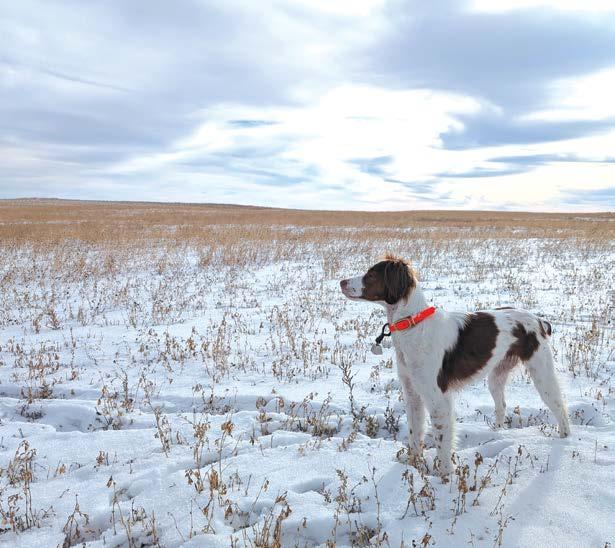
Article and photos submitted by PATTI LEE & RANDI BENKO
Patti Lee and Randi Benko are the founders of Bad Apple Bird Dogs (BABD). They are passionate about upland hunting with their pointing dogs. They have titled in CKC pointing events, NSTRA, and had much success hunting in southern Saskatchewan.
22 SPRING 2024 | PQ 2.2
Above photo: Joe, Randi, Patti and Lane - group photo with the dogs near Oungre, Saskatchewan.
Background photo: Teal - in a field somewhere in Southern Saskatchewan.
IS MY PET OVER WEIGHT?
We've become so used to seeing our dogs a little on the pudgy side, when we see a lean dog, who is actually their ideal weight and very healthy, we often hear..."Your dog is too skinny! Feed that dog a burger or something!"
Keeping our pets lean is always best for their health! It's easier on their joints, their organs and their overall health and wellbeing!
One thing many pet parents try when a furry guy needs to lose some weight is a pet weight loss food. Weight loss food for a pet is similar to a fad diet for humans but not as healthy.
Do you want your pet to lose or maintain weight? What is ONE food you could eat for the rest of your life that
provides you with all the required nutrition you would need? The answer is...none! It doesn't exist and it doesn't exist for our pets either!
The best way to help our furry family lose or maintain an ideal weight is through quality diet and exercise! The same way it is for us!
If you've got a furry friend who needs to shed some pounds, here's a way to do that!
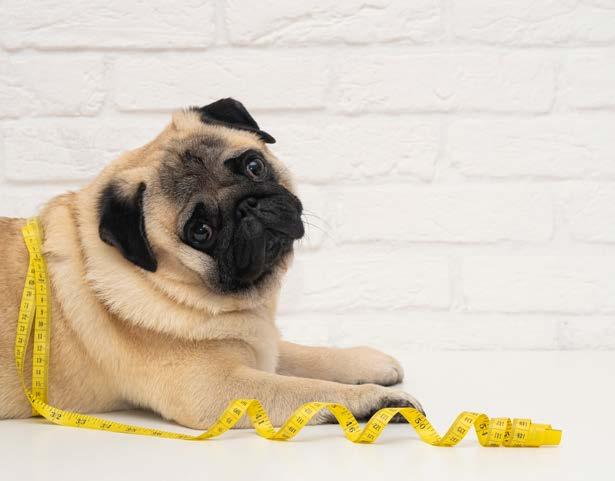
IT'S AS EASY AS 1-2-3!
MAKE A MEAL PLAN
Making a meal plan that includes healthy treats is key!
REGULAR EXERCISE
If your furry friend can't go for a long walk, take several short walks to keep those legs moving!
HEALTHY FOOD
If you're feeding a dry diet, your best bet is to look for a protein rich, nutrient dense, low carb, premium food. Just like us, our pet's key to a healthy weight will be less processed food and more fresh, whole foods!
CARLY PATRYLUK House of Paws Pet Boutique
23 PAWQuarterly
Inspire. Educate. Motivate.
Do you have a story you would like to share?
PAW Quarterly invites you to submit your story for a chance to get published in an issue of PQ.


published in PQ!
Get
Email: publish@pawquarterly.com
24 SPRING 2024 | PQ 2.2

WORD SEARCH IN THIS ISSUE

Created with TheTeachersCorner net Word Sear PQ2.2 ADVOCATE BEHAVIOUR BITE BREED COMMUNICATION CONNECTION DORMANCY FEAR FIELD GUNDOG MARKERS MODIFICATION PATTERN PREVENTION PROTECTION Name: H B Q S Y O W R U O I V A H E B O O U T V K V H P I J H C C C S W H Z J N T N M B N H H C M A R K E R S L O V D W O E G C N I T V N K Q N O I T A C I F I D O M L O Z F I C X T P S C K H G X C R D L G T I Y I S Y K M H G Z L N N E D N O Y E F T C L P R E V E N T I O N V U R T E L I C N I P V B S S S M I P J G I K X K E O E A P R F E O Y I T I U I K Y F M Q M S T M U R Q Z N T C I Y Y A M J I Q W E Z O R E A A C Z E P Z A J S L P D F V P B R O F T E E N S H Q L V F V Y J E S N X P D R T A N F B V H M A V G M I R J R K H C R S O C I A L I Z E X R R Y K N E Z P E V C S T O D E E R B E T H M J I T D E P U D E A Z V N G S C E B M T U X T X I R V N L T U N D D O R S H T D K B A L W G D H H E T D M A Y C V T L A I S P R C O M M U N I C A T I O N N L F N Z F A V Q X R X T X F L E N S H Y T E F A S ADVOCATE BEHAVIOUR BITE BREED COMMUNICATION CONNECTION DORMANCY FEAR FIELD GUNDOG MARKERS MODIFICATION PATTERN PREVENTION PROTECTION RETRIEVE SAFETY SOCIALIZE TIMING TREE If you can imagine it... WE CAN PRINT IT. Serving the printing needs of Regina and area since 1965. e. sales@westernlitho.ca p. 306.525.8796 tf: 1.877.445.4846 www.westernlitho.ca WESTERN ––––– LITHO –––––PRINTERS 25 PAWQuarterly
SPRING Treats

Recipes are intended to be a treat. If your pet has any health issues, or if you have any concerns, consult your pet’s veterinarian before offering this treat to your dog.

Flower Power COOKIES
INGREDIENTS
• 1¼ cups Oat Flour
• 1¼ cups Rice Flour
• 1 cup of shelled sunflower seeds (unsalted)
• ½ cup of rolled oats (not quick oats)
• ½ cup chopped dried blueberries or cranberries
• ¼ cup Honey
• 3 Tbsp apple sauce
• 1 egg
• ½ cup of water (1 Tbsp at a time.)
METHOD
1. Preheat oven to 350°F.
2. Combine ingredients except the water and save some sunflower seeds for the tops.
3. Add the water slowly and adjust if needed. If the dough is too dry, add more water. Too wet, add more flour.
4. Roll out to ¼-inch thick and cut out cookies.
5. Place them on a baking sheet and bake for 20 - 25 minutes or until golden brown. Check often and enjoy when cooled.

TIP
You can make your own oat flour by blending oats in a food processor until they are a consistency comparable to flour.
26 WINTER 2024 | PQ 2.1

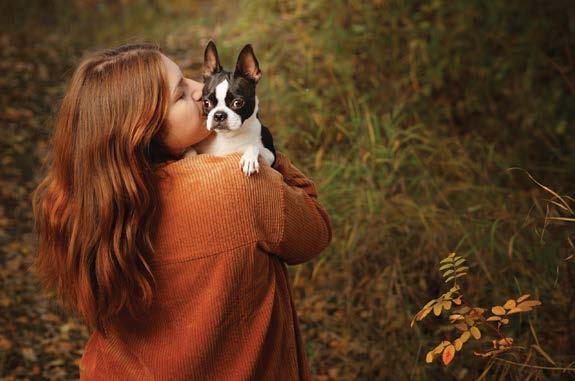



Lisa Brice, CPA www.bricephotography.net 306.533.8620 Photography the story of the between Pets and People Follow us and be a part of our V.I.P. list. Instagram Facebook SPECIAL OFFER 27 PAWQuarterly
AB • ALBERTA
SK • SASKATCHEWAN MB • MANITOBA

APRIL
Events calendar
APRIL
APR 6/7, 2024 AB
AAC ‑ Agility Trial Dogs At Large Neitak Equestrian Centre 50416 RGE RD 10, Stony Plain, AB zazulat@telusplanet.net www.dogsatlarge.ca
APR 7, 2024 MB
AAC Agility Trial Crocus Obedience and Kennel Club Keystone Centre (Ace Arena) 1175-18th Street, Brandon, MB kintyre@wcgwave.ca www.crocusdogs.com
APR 13, 2024 AB
SDDA Nosework Trial Shaughnessy Community Hall 133 3rd Street, Shaughnessy, AB shaunaferby@hotmail.com www.sdda.ca
APR 13/14, 2024 SK
AAC Agility Trial Standsure Agility Club 3D Distributors, 395 - 38 St E, Prince Albert, SK standsure@sasktel.net www.facebook.com/groups/www.bordercollie.ca
APR 13/14, 2024 AB
AAC Agility Trial OC Agility
Sturgeon County Agriplex - Indoors 25021 Twn Rd, 554, Morinville, AB trials@ocagility.net www.ocagility.com
APR 14, 2024 AB
AAC ‑ Agility Trial Rocky Mountain Agility Club Okotoks Agricultural Society, Okotoks, AB rmactrialsecretary@gmail.com www.rockymountainagility.com
APR 19 21, 2024 AB
BARN HUNT
Prairie Dog Sports Inc. Lacombe and District Agricultural Society
Show Barn
4210 58 Street, Lacombe AB prairiedogsports@outlook.com www.prairiedogsports.ca
APR 19‑21, 2024 MB
BARN HUNT 4U Farms lot 833 PR247, Howden, MB Faye@4ufarms.ca www.4ufarms.ca
APR 27, 2024 AB
AAC Agility Trial Performance Agility Club of Edmonton Neitak Equestrian Centre 50416 RGE RD 10, Stony Plain, AB president@paceagility.org www.paceagility.org
APR 27/28, 2024 SK Flyball
Diamonds in the Ruff, Spring Fling No Bling Dalmeny Arena, 215 Railway Avenue diamondsflyball@gmail.com https://diamondsflyball.ca/?page_id=30
APR 28, 2024 AB
SDDA Nosework Trial
Alberta Sports Hall of Fame 4200 Queen Elizabeth II Hwy #102 Red Deer, AB kerriisnot@outlook.com www.sdda.ca
MAY
MAY 3, 2024 SK
AAC Agility Trial
Aberdeen Equestrian Sports Centre, Aberdee, SK saaagility@gmail.com
www.saskatchewanagilityassociation.ca
MAY 3 5, 2024 AB
BARN HUNT
Sleep Rover, Side building, Back Entrance 735 41 Ave NE, Calgary, AB info@culturedcanines.ca www.culturedcanines.ca
JUNE
MAY
28 SPRING 2024 | PQ 2.2
MAY 3 5, 2024 SK
SDDA Nosework Trial
Pilot Butte Recreation Centre 222 Diamond Place, Pilot Butte, SK hdscentdetection@gmail.com www.sdda.ca
MAY 4/5, 2024 MB
Flyball
Flyball N~R~G, Turn up the NRG Dumbledogs 974 Powell torhos@mts.net www.facebook.com/flyballnrg
MAY 4/5, 2024 AB
AAC Agility Trial OC Agility
Sturgeon County Agriplex 25021 Twn Rd, 554, Morinville, AB trials@ocagility.net www.ocagility.com
MAY 11/12, 2024 SK
Flyball
High Octane Flyball, Woof Wars 2024 Dalmeny Arena, 215 Railway Avenue caissiej@gmail.com
https://www.facebook.com/highoctaneflyball
MAY 11/12, 2024 AB
AAC ‑ Agility Trial Dog On It Sports
54221 Hwy 21, Strathcona County, AB dogonitsports@gmail.com www.dogonitsports.com
MAY 11/12, 2024 AB
AAC ‑ Agility Trial Rocky Mountain Agility Club Okotoks Agricultural Society, Okotoks, AB rmactrialsecretary@gmail.com www.rockymountainagility.com
MAY 17, 2024 SK
AAC ‑ Agility Trial Standsure Agility Club 3D Distributors, 395 - 38 St E, Prince Albert, SK standsure@sasktel.net
www.facebook.com/groups/www.bordercollie.ca
MAY 17‑20, 2024 AB
BARN HUNT
Prairie Dog Sports Inc.
Lacombe and District Agricultural Society Show Barn, 4210 58 Street, Lacombe AB prairiedogsports@outlook.com www.prairiedogsports.ca
MAY 17 20, 2024 MB
BARN HUNT
Westman Rat Wranglers
Quarry K9 Day Camp & Resort Inc. NE corner of Hwy #7 & Hwy #67, Stonewall, MB quarryk9@gmail.com www.facebook.com/profile. php?id=100057627940724
MAY 18/19, 2024 AB
SDDA Nosework Trial Softball Valley 14 Riverbottom Road N, Lethbridge, AB shaunaferby@hotmail.com www.sdda.ca
MAY 21, 2024 AB
AAC ‑ Agility Trial Muthut Agility Berryman Ranc
70 50050 Rge Rd 233, Leduc County, AB trials@seespot-run.com www.seespot-run.com
MAY 25, 2024 AB
SDDA Nosework Trial Global Training Centre Township Rd 240, Wheatland County Strathmore, AB sportcanines@gmail.com www.sdda.ca
JUNE
JUN 4, 11, 18 & 25, 2024 AB
AAC ‑ Agility Trial Muthut Agility, Berryman Ranch
70 50050 Rge Rd 233, Leduc County, AB trials@seespot-run.com www.seespot-run.com
JUN 14, 2024 SK
AAC Agility Trial
Aberdeen Equestrian Sports Centre, Aberdeen, SK saaagility@gmail.com
www.saskatchewanagilityassociation.ca
JUN 14, 2024 MB
AAC Agility Trial
Backyard Agility Dogs
1865 Janisch Rd, Petersfield, MB laurie@backyardagilitydogs.ca
www.backyardagilitydogs.ca
JUN 14 16, 2024 AB
BARN HUNT
Prairie Dog Sports Inc.
Lacombe and District Agricultural Society Show Barn, 4210 58 Street, Lacombe, AB prairiedogsports@outlook.com
www.prairiedogsports.ca
JUN 21, 2024 AB
AAC Agility Trial
Dog On It Sports 54221 Hwy 21, Strathcona County, AB dogonitsports@gmail.com
www.dogonitsports.com
JUN 23, 2023 AB
SDDA Nosework Trial
St. Leo School, 6220 Lakeview Dr SW, Calgary, AB sportcanines@gmail.com
www.sdda.ca
JUN 28, 2024 AB
AAC Agility Trial
Top Spot Agility
Okotoks Agricultural Society, Okotoks, AB topspotagility@gmail.com
www.facebook.com/groups/302176573323264/
JUN 28 JUL 1, 2024 SK
BARN HUNT
Flatlands Kennels Boarding and Training, Left building SE25-48-23W3 RM, Maidstone, SK info@culturedcanines.ca www.culturedcanines.ca
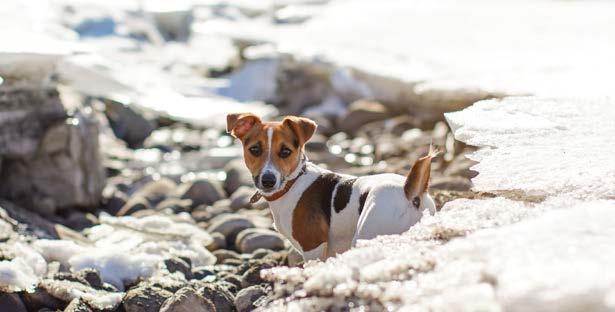
To see the events calendar or to submit your own event visit pawquarterly.com /events.
29 PAWQuarterly
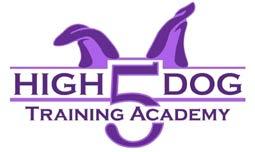
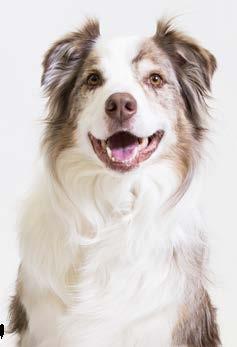
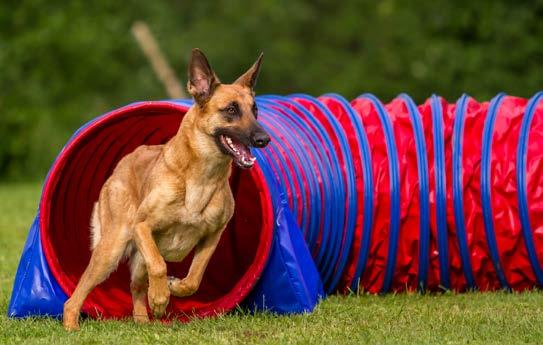
Positive, reward-based training for everyday life! At High 5 Dog Training Academy we offer classes, handler information workshops, and dog sport sampler classes. See our website for a full list of classes. contact us at highfivecanine@gmail.com high5dogtraining.ca 30 SPRING 2024 | PQ 2.2 Share your event, workshop, or seminar with us! Help us bring the most current information to our readers by filling out the event submission form at pawquarterly.com/events and your event will be posted on the PQ Events Calendar. Events calendar SUBMISSION FORM EVENT


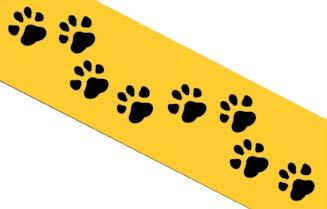

31 PAW Saskatchewan’s Largest Pet Friendly Body Shop Network! North Location 3910 Rochdale Boulevard NEW Central Location 601 Albert Street NEW LOCATION BOOK YOUR CLAIM TODAY! uccregina.com
GET YOUR MOTOR RUNNING
Are you ready to head out on the highway this Spring?

True Freedom




























 ALEX ZDANOWSKI
Judge, North American Flyball Association
ALEX ZDANOWSKI
Judge, North American Flyball Association






































